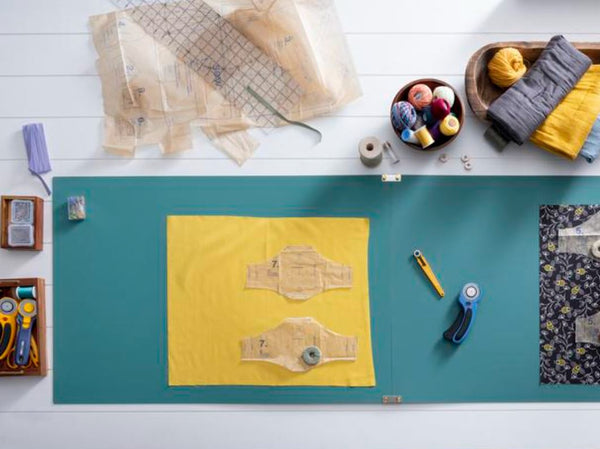
Sewing Room Necessities
Whether you’re new to sewing, or have had a sewing room for years, OLFA has created a checklist of items we feel are essential to have handy when you’re sewing and quilting.
Basic supplies
Photo: Daisi Toegel
Sewing machine – purchase the best machine, with an acrylic table, you can afford. Purchase from a local sewing center as they offer classes that will help you become skilled at using it, plus will be able to help you maintain your machine. If you are given a machine or find one at a neighborhood sale, take it to a sewing machine store for a tune up to ensure it’s in good, working order. If you’re going to be piecing fabric for quilting, purchase a ¼” sewing machine foot to get an accurate seam allowance. Purchase a packet of extra bobbins, too.

Photo: Amanda Brown
Pins – choose long straight pins with a plastic or glass head. They won’t bend as readily, are easier to pull out as you sew, and if you drop them on the floor, it won’t be as hard to find them. Clips are also another alternative to some pins.
Needles – machine sewing on cotton fabric is easiest with universal sewing machine needles. On the packaging you’ll see 130/705H, with 80/12 printed under it. There are heavier needles available if you are going to sew with denim or thicker fabric. For hand work, choose a variety pack of hand-sewing needles until you find a size that works best for you.
Seam ripper – mistakes happen so keep a seam ripper handy. The OLFA Cushion Grip Art Knife is a go-to tool for ripping seams. The slightly weighted bottom provides balance and stability in your hand. The OLFA Beginner Craft Knife with Stand is another good choice. It’s lightweight and only the smallest amount of blade is exposed.

Photo: Aurifil
Thread – 50wt thread is the best for piecing cotton fabric, is easy to find, and comes in a variety of colors.
Photo: Amanda Brown
Fabric – 100% cotton fabric is recommended for quilting. For garment sewing, follow the suggestions on the pattern.
Photo: Daisi Toegel
Iron and ironing board – purchase an iron that has a variety of temperature settings, and a reservoir for water if you want to use steam. A spray bottle filled with clean water is handy to have, too. Use an adjustable ironing board to get a height that’s perfect for you. Some stores sell a board ironing surface that lays over the top of your ironing board to give you more space.
Pincushion – keep your pins within reach with a pincushion. There are traditional soft ones or magnetic ones. Have fun and make your own pincushions! (stay tuned to next months newsletter for some free pincushion patterns!)
Lighting – better lighting improves your sewing, doesn’t strain your eyes, and makes sewing more fun. If you don’t have good overhead lighting, look for task lights you can adjust to shine on your sewing machine bed or hand work.
Photo: Amanda Brown
Organizing tools – look for bins and baskets that fit your shelves, making it easy to keep your supplies organized. If you don’t have a dedicated sewing space, look for ones that are portable.
Cutting tools
Rotary cutter – OLFA transformed quilting with the invention of the rotary cutter in 1979. Now, there are a variety of cutters that serve many different uses. See the Rotary Cutter Collection.
For beginners, a 45mm RTY-2/C Quick-Change Rotary Cutter is the best option for quick fabric cutting of sewing and quilting projects. For heavier fabrics or multiple layers, try one of OLFA’s 60mm rotary cutters.
Self-healing cutting mat – rotary cutters need to have a cutting mat beneath them. The double-sided self-healing finish on OLFA’s cutting mats reseals surface cuts, providing a continually smooth surface for all cutting projects. Because there are a variety of sizes to choose from, pick one that fits your cutting area best. Purchase the largest mat you’re able to. Rotary Mat Collection
Acrylic ruler – a rotary cutter needs to glide along the edge of an acrylic ruler for sharp, precise cuts. OLFA’s frosted acrylic surface allows black imprinted numbers to be read effortlessly while keeping your ruler firmly in place as you cut. The system is designed so that the frosted ruler, rotary cutter, and self-healing mat work together to give the best cuts over and over. Acrylic Ruler Collection
Scissors – OLFA’s 5-Inch Precision Appliqué Scissors are just right for snipping threads at the sewing machine or hand cutting small shapes. Because they’re designed for left or right-hand use, they’re easy to grab when you need them. Scissor Collection
Furniture
Sewing table – look for a table that has ample room for your machine and the acrylic surrounding it, as well as a place for your scissors, pincushion, and other necessities. It should be at a height that is comfortable, about 28” tall. When you’re sitting at it you don’t want to be hunching over your machine. Bonus if there are shelves or drawers in it! If you don’t have a permanent sewing area, choose a table that’s easy to fold and store.
Photo: Daisi Toegel
Cutting table – your table should sit solidly on an even floor and be large enough to accommodate a cutting mat. The height is as important as the cutting surface. Approximately 35” - 36” is an ideal height for most quilters. You don’t want to have to stretch too far when you cut or lean over the table to avoid strain on your back, neck, and arms. If you find your table is too low, purchase dorm bed risers to give yourself some height.
Photo: Amanda Brown
Chair – many quilters use an adjustable office chair with ergonomic components, such as lumbar support. Adjust the height so your feet are firmly on the floor. If you use a standard chair, add a cushion or two to give yourself more height.
Need more ideas on what you should have in your sewing room? Check out favorite tools from the toolboxes of our OLFA Experts here!











